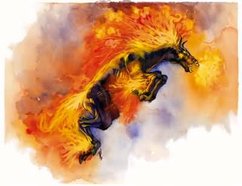The Púca is a fairy creature of Celtic folklore, notably in Ireland and Wales. The Púca is considered by many to be the most terrifying of all faery creatures. One reason for this is its appearance, but its powers are also feared.
Also known as Pooka, Phooka, Phouka, Púka, Pwca in Welsh, pouque in Dgèrnésiais, also Glashtyn, Gruagach.
Nature
Etymology
From the Old Irish 'poc', 'a male goat'. Another plausible origin is the Scandinavian pook or puke, meaning 'nature spirit'.
Description/Morphology
According to legend, the Púca is an adroit shapeshifter, capable of assuming a variety of terrifying forms. It may appear as an eagle or as a large black goat, but it most commonly takes the form of a sleek black or white horse with a flowing mane and glowing yellow eyes. In parts of County Laois, the pooka becomes a huge, hairy bogeyman who terrifies those abroad at night; in Waterford and Wexford, it appears as an eagle with a massive wingspan; and in Roscommon, as a black goat with curling horns By the beginning of the 21st century, depictions and conceptions of the Púca have changed from a fierce, terrifying spirit to a harmless, shy, garden-gnomish.
Powers/Weaknesses
The Púca is a creature of the mountains and hills, and in those regions there are stories of it appearing on November Day and providing prophecies and warnings to those who consult it.
The Púca has the power of human speech, and has been said to call those it feels have slighted or offended it out of their homes for a ride. If they fail to appear, it will tear down fences, scatter livestock, and create general mayhem.
Behavior
It is said to waylay travellers and others about at night, and if it is able to toss them onto its back, it will, at very least, provide them with the ride of their lives, from which they will return forever changed. A similar creature, the kelpie (Water-horse), will allow itself to be saddled and ridden, but if it is ever taken next to a river or pond, it will carry its hapless rider into the water and rip him to pieces.
In some regions, the Púca is spoken of with considerably more respect than fear; if treated with due deference, it may actually be beneficial to those who encounter it.
History/Beliefs
Culture
Certain agricultural traditions surround the Púca. It is a creature associated with Samhain, the third Pagan (Celtic, Wiccan) Harvest Festival, when the last of the crops is brought in. Anything remaining in the fields is considered "puka," or fairy-blasted, and hence inedible. In remote areas of County Down, the pooka becomes a small, deformed goblin who demands a share of the crop at the end of the harvest: for this reason several strands, known as the 'pooka's share', are left behind by the reapers. Nonetheless, November Day (November 1) is the Púca's day, and the one day of the year when it can be expected to behave civilly.
Art / Fiction
Popular culture
- Puck, the goat-footed satyr made famous in Shakespeare's A Midsummer Night's Dream
- Americans are most likely to be familiar with an only slightly mischievous version of the Púca from the stage play and movie Harvey (movie)|Harvey, in which the title character, an invisible six-foot-three-and-a-half-inch rabbit, is described by the movie's main character Elwood P. Dowd as a pooka.
- Pooka is also a character in the classic video game Dig Dug.
- Phooka is a type of shape-shifting ghost noted in the game Ghost Master.
- The Pooka is a ghost horse in Crewel Lye, a fantasy novel by Piers Anthony.
- The Pooka (World of Darkness) is also a type of character in the fae-based White Wolf role-playing game Changeling: The Dreaming.
- Pooka is the name Anastasia gives the mischievous tag-along pup in Fox Animation Studios' Anastasia.
- One of the main characters of Emma Bull's best-known book, War for the Oaks, is a Púca (spelled Phouka in the book, usually).
- "The Pooka MacPhellimey, a member of the devil class", is a main character in Flann O'Brien's classic novel At Swim-Two-Birds.
- A púca appeared briefly in the ghost comedy movie "High Spirits (film)|High Spirits" as a talking white pony.
- In the "Bruce Coville's Book of" anthology series, a story called "The Pooka" appears in the third entry, "Bruce Coville's Book of Ghosts".
- Martyn Turner called a púca into service as the protagonist of a series of newspaper cartoons.
- Gruagach has appeared in Mike Mignola's graphic novel series, Hellboy.
- In Stephen King's Dreamcatcher (novel)|Dreamcatcher, Kurtz describes the mission as stealthly like the Phooka.
- The Phooka is a type of fay in The Spiderwick Chronicles that speaks in rhymes and shape-shifts.
- In the Reefs Of Earth the aliens are called Puca.
- Pooka is the name of Tim Rhymeless' familiar in Wild ARMs 2, and is capable of changing form to facilitate the game's summons.
- Pooka helps the girl, Jenny and the Ghost Tamsin in the book by Peter S. Beagle entitled, Tamsin.
- Pooka is a monster in Dark Age of Camelot
- A Pooka, as a wandering spirit that is part man and part donkey, "helps" the main character in the children's book Jamie O'Rourke and the Pooka by Tomie DePaola.
See also

